Video: Iguana running before snakes to save life

It’s the stuff of nightmares: a rock face that comes alive with a writhing mass of snapping serpents seemingly hellbent on working together to capture and consume a defenceless young marine iguana.
This jaw-dropping scene aired as part of the new series of the BBC’s flagship natural history programme, Planet Earth II, and seems to have captured the imagination of millions.
Filmed on Fernandina Island in the Galapagos, the Galapagos Racer (Philodryas biserialis) is a slim, fast-moving, mildly venomous snake that reaches lengths of up to 120cm.
They were filmed during their best feeding opportunity of the year, as young iguanas are born and make a dash for the safety of the higher rocks above. Snake eyesight has evolved to quickly detect movement – and once they spot a target, their reactions can appear highly aggressive and relentless in pursuit, reports the Independent.
It’s all too easy to demonise the snake, and for years that’s exactly what the media has encouraged. Reports involving snakes are commonly misrepresented or deliberately sensationalised. Snakes are often portrayed as slimy, cold, angry sticks with teeth rather than anything resembling a living, breathing creature. This of course does little to alleviate public ophidiophobia, an irrational fear of snakes.
In fact, my first break as a wildlife presenter came about following a phone call from the BBC Natural History department regarding snakes, having seen me deliver a talk for the British Association of Science at Cardiff University.
‘We’d love to shoot a documentary about adders with you,’ the voice on the other end of the phone exclaimed. ‘We especially want to see the fangs, and the venom … just how much venom can we see from milking an adder?’
Taking a deep breath, I clarified through gritted teeth that Britain’s only venomous snake was both shy and reclusive and not at all aggressive. It was a delicate snake that could easily be injured, and it would be unethical to undertake such an exercise just for the camera. A documentary of that calibre would present adders in a poor light, and it was not a project I would want to be part of.
‘Okay,’ the voice replied, seemingly without hearing a word I had just uttered. ‘Do you know anyone else that would be interested?’
I remember thinking that that would be the last chance I’d ever have to work for the BBC, but also feeling that I’d made the right decision. A couple of days later, though, I received another call telling me that the documentary had been poorly thought out and that a decision had been made to cancel the production. As you can imagine, I was relieved. And rather than hinder my career, my stand attracted BBC producers with better judgement, and eventually led to me presenting my own primetime BBC One wildlife series, Rhys Jones’s Wildlife Patrol.
But while it worked out well for me in the end, the same cannot be said for the racer snake, which has already been roundly and colourfully attacked. Rather than capturing a coordinated attack from snakes hunting as a pack, the clip from Planet Earth IIactually shows a number of snakes acting individually, on instinct. The time of year when these iguanas hatch is for these snakes the equivalent of Black Friday bargain hunting – it’s every snake for itself, because if they miss out here, they’ll go hungry. Collectively, the actions of these snakes can appear terrifying, but once a snake eats it loses its desire to hunt again.

 Agency
Agency